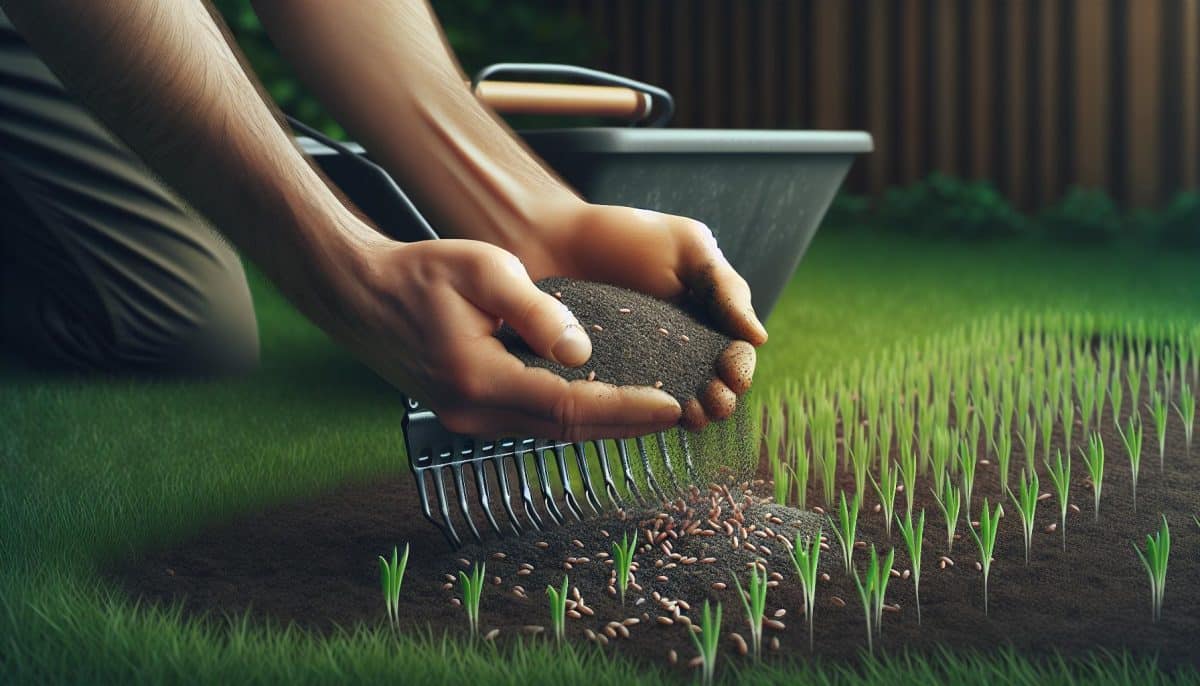
Deciding whether to fertilize when you overseed your lawn is a common dilemma for gardeners aiming for that lush, green carpet. It’s a crucial step that can significantly impact the health and appearance of your lawn. Getting this balance right is essential, especially if you’re during battling weeds while trying to encourage new growth.
Understanding the relationship between seeding, fertilizing, and weed control is key. It’s not just about throwing down seeds and hoping for the best; it’s about creating the perfect environment for those seeds to thrive. Let’s jump into the specifics of fertilizing during the overseeding process and how it can make or break your lawn’s success.
The Importance of Fertilising When Overseeding
When you decide to overseed your lawn, integrating fertilisation into the process isn’t just beneficial—it’s necessary for achieving optimal results. Fertilising when overseeding serves as the cornerstone for a lush, vibrant lawn, ensuring that the newly introduced seeds have all the nutrients required for germination and growth. This synergistic approach propels your lawn towards success by significantly enhancing the effectiveness of overseeding.
Firstly, understand that overseeding aims to improve lawn density and introduce more resilient grass varieties. But, without the right nutritional foundation, these goals remain out of reach. Fertilisers rich in nitrogen, phosphorus, and potassium play pivotal roles in this scenario. Nitrogen promotes vigorous leaf growth, phosphorus fosters strong root development, and potassium enhances overall plant health, making your grass more resilient to stress.
Also, when introducing cool-season grasses into warm-season lawns for year-round greenery, the nutrient demands of your lawn increase. Using a fertiliser tailored to the needs of the specific seeds you’re planting not only supports their development but also aids the existing lawn. This holistic nourishment approach ensures a seamless integration of the new grass with the old, preventing patches and uneven growth.
Incorporating soil aeration into the fertilising and overseeding process amplifies these benefits. Aerating your lawn before overseeding allows better penetration of both seeds and fertiliser, fostering an environment where new grass can thrive. Whether you opt for core or spike aeration, creating those small holes in your lawn makes a big difference in the success of your overseeding efforts.
Balancing soil pH is another critical step that shouldn’t be overlooked. The ideal pH level for most grass types falls between 6.2 and 7.0. Applying products like MAGICAL to adjust soil pH ensures that your lawn’s environment is perfectly primed for both seed germination and nutrient uptake. Adjusting the soil’s acidity or alkalinity as needed means that the fertiliser and seeds work in harmony, setting the stage for a healthy, dense lawn.
Remember, every step you take towards creating the ideal conditions for your lawn, from fertilising to adjusting soil pH, works together to achieve the lush, green carpet you desire. By understanding and implementing these strategies, you’re not just overseeding; you’re revolutionising your lawn care routine.
Benefits of Fertilising During Overseeding

When you’re on the mission to boost your lawn’s appearance and health by overseeding, understanding the pivotal role of fertilising can’t be understated. This process goes hand in hand with overseeding to ensure you’re not just sowing seeds but also nurturing a fertile ground for their growth.
Improved Seed Germination
At the heart of a successful overseeding project lies your ability to foster optimal seed germination conditions. Fertilising your lawn during overseeding is a critical step in achieving this. The application of a starter fertiliser provides essential nutrients that are directly accessible to the new seeds. Phosphorus, in particular, is known for its role in encouraging strong root development. By introducing a balanced mix of nutrients, you’re effectively boosting your seeds’ chances of sprouting into healthy grass.
Research indicates that soils sufficiently supplied with necessary nutrients can enhance germination rates significantly. It’s not just about covering your lawn with seeds but ensuring each has the best start possible.
Enhanced Growth of New Grass
Once your seeds have germinated, the journey towards a lush and dense lawn is only beginning. The newly sprouted grass needs continuous support to thrive, and this is where fertilising plays a crucial part. Starter fertilisers contain not only phosphorus but also Nitrogen and Potassium, each serving a unique purpose in the growth of new grass. Nitrogen fuels leaf growth, giving your lawn that desirable green lustre, while Potassium strengthens the grass against diseases and stresses, such as drought and cold.
A study highlighted the importance of Nitrogen in the rapid establishment of overseeded grass, showing a direct correlation between Nitrogen levels and the speed at which new grass matures.
By understanding the benefits of fertilising during overseeding, you position yourself to achieve not just germination but the robust growth of new grass. Remember, the objective is to create a conducive environment for seeds to not only germinate but to flourish, integrating seamlessly into your existing lawn and enhancing its overall health and appearance.
Best Practices for Fertilising While Overseeding

When you’re looking to give your lawn a facelift through overseeding, coupling this process with the right fertilisation techniques is crucial. This strategic combination ensures that your new grass gets the best possible start. Here’s how you ensure that your fertilising complements your overseeding efforts effectively.
Choose the Right Type of Fertiliser
The first step towards a lush lawn is selecting the appropriate fertiliser. Starter fertilisers are highly recommended when overseeding because they’re formulated to provide newly germinating seeds with the essential nutrients required for optimum growth. These products are rich in phosphorus, a key element that supports root development in young grass. Unlike regular fertilisers, starter options also have an ideal balance of nitrogen and potassium which supports both the green leaf development and the overall health and stress resistance of the new grass.
It’s important to stay away from weed-and-feed products during this phase. While tempting, these fertilisers can inhibit the growth of your new seeds. Stick to a high-quality starter fertiliser for the best results.
Timing is Key
Timing the application of fertiliser is just as important as choosing the right type. Apply the fertiliser the same day you overseed to ensure that the nutrients are available right from the start of the seed’s life cycle. This initial boost helps the seeds to germinate more effectively and establish a strong root system early on.
Research indicates that the first four to six weeks are critical for newly overseeded lawns. During this period, the young grass is most vulnerable and requires ample nutrients to develop into a robust and healthy lawn. Scheduling a second application of fertiliser about five weeks after the initial overseeding can further support this development, ensuring your new grass thrives.
Proper Application Techniques
Effective application of fertiliser is essential to maximize its benefits. Here are a few tips to ensure you’re doing it right:
- Use a spreader: For an even distribution, always use a quality broadcast or drop spreader. This prevents over-concentration of fertiliser in certain areas which could potentially burn the young grass.
- Follow the instructions: Overfertilising can be as detrimental as underfertilising. Stick to the recommended application rates on the fertiliser package to avoid harming your new seeds.
- Water wisely: After applying fertiliser, water your lawn lightly to help dissolve the fertiliser and carry the nutrients down to the soil. But, be cautious not to overwater, as excessive moisture can wash away the nutrients or cause fungal diseases.
Implementing these fertilisation best practices while overseeding can dramatically improve the success rate of your lawn renovation project. By providing your new seeds with the right nutrients at the right time and using proper application techniques, you’re setting the stage for a vibrant, healthy lawn that will last for seasons to come.
Conclusion
Fertilising when you overseed is not just a recommendation; it’s a crucial step in ensuring the success of your lawn renovation efforts. By selecting the appropriate starter fertiliser and timing its application perfectly, you’re setting the stage for robust root development and optimal grass health. Remember, the key lies in the details—using a spreader for even distribution, adhering to recommended application rates, and watering wisely. These practices are your ticket to a lush, vibrant lawn that’ll be the envy of the neighbourhood. So don’t overlook the importance of fertilisation in your overseeding process; it could very well be the difference between a good lawn and a great one.
Colin Macmillan is a seasoned entrepreneur and the CEO of Riverwood Landscape, a leading landscaping company based in Canada. He has been at the helm of the company since leaving high school, demonstrating his strong leadership skills and business acumen.
Colin’s expertise lies in various aspects of landscaping, including lawn care, interlocking, sod installation, and commercial maintenance. His hands-on approach and dedication to the craft have been instrumental in building Riverwood Landscape into a reputable brand.
One of his most notable achievements is the creation of a successful landscape franchise that services multiple locations. This accomplishment underscores his strategic thinking and ability to scale operations effectively.
Colin has also had the privilege of working with Guelph Hospital for landscaping and maintenance, a testament to the trust and reliability that his company has earned over the years.
His professional mission is to offer the best services and experiences for customers, a goal that he tirelessly pursues. Colin’s commitment to excellence and customer satisfaction continues to drive the growth and success of Riverwood Landscape.








